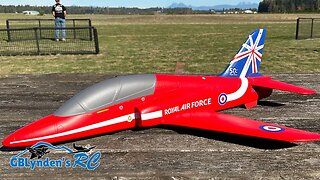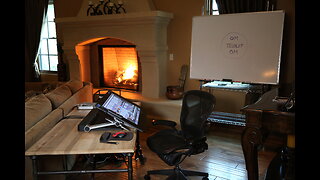RC Plane Crash Landing - Giant Scale Spitfire WWII Warbird at Warbirds Over Whatcom
This RC Plane Crash Landing video featuring a Giant Scale Spitfire WWII Warbird took place at Warbirds Over Whatcom last July. My girlfriend and I were enjoying our exciting local Warbird Event when this happened.
Link to similar RC Planes: https://bit.ly/3Uio952
The links in this description are affiliate links. They give me a small commission on sales which helps support the channel and keep it independent: https://www.amazon.com/shop/gblyndensrc
Visit https://www.gblynden.com/ to learn more about the hobby!
RC Accessories:
- Spektrum Smart Checker: https://bit.ly/329hl12
- Spektrum IX20 Radio: https://amzn.to/3qFTbHe
- Spektrum AR620 Receiver: https://bit.ly/3Aay021
Other Fun RC Planes:
- Arrows Husky 1800mm PNP STOL RC Plane: https://bit.ly/3v3qQM9
- Arrows BAe Hawk EDF Jet: https://bit.ly/2VY0HB7
- Arrows T-33 EDF Jet: https://bit.ly/3h3Z24a
- Arrows F-86 EDF Jet: https://bit.ly/3hIli3C
- Arrows F-15 EDF Jet: https://bit.ly/3Cxi10D
- Arrows RC MiG-29 EDF Jet: https://bit.ly/2ZDmjBY
- Arrows RC Marlin EDF Jet: https://bit.ly/2LUe4cN
- Arrows T-28 Trojan RC Warbird: https://bit.ly/2LOr3N4
- Arrows Bigfoot RC Plane: https://bit.ly/2TJliVh
Note: I am on the camera, not the sticks. I hope that saves silly comments about my flying ability.
There were other really fun video clips I captured at that I haven't yet had a chance to edit and post, but I couldn't wait any longer to share this one with you guys of the Spitfire with a reported 90" wingspan.
I hope you enjoy and cringe watching this Spitfire RC Plane Crash as much as my girlfriend and I did!
GB
Here is some history for the scale version of this plane:
The Supermarine Spitfire is a British single-seat fighter aircraft that was used by the Royal Air Force and many other Allied countries throughout the Second World War. The Spitfire continued to be used as a front line fighter and in secondary roles into the 1950s. It was produced in greater numbers than any other British aircraft and was the only British fighter in continuous production throughout the war.[5]
The Spitfire was designed as a short-range, high-performance interceptor aircraft[6] by R. J. Mitchell, chief designer at Supermarine Aviation Works (which operated as a subsidiary of Vickers-Armstrong from 1928). Mitchell continued to refine the design until his death from cancer in 1937, whereupon his colleague Joseph Smith became chief designer.[7] Where speed was seen as essential to carrying out the mission of home defense against enemy bombers,[6] the Spitfire's thin cross-section elliptical wing allowed it a higher top speed than several contemporary fighters, including the Hawker Hurricane.[8]
During the Battle of Britain (July--October 1940), the Spitfire was perceived by the public as the RAF fighter, though the more numerous Hawker Hurricane shouldered a greater proportion of the burden against the Luftwaffe. The Spitfire units had a lower attrition rate and a higher victory-to-loss ratio than those flying Hurricanes.[9]
After the Battle of Britain, the Spitfire became the backbone of RAF Fighter Command, and saw action in the European, Mediterranean, Pacific and the South-East Asian theatres. Much loved by its pilots, the Spitfire served in several roles, including interceptor, photo-reconnaissance, fighter-bomber, carrier-based fighter, and trainer. It was built in many variants, using several wing configurations.[10] Although the original airframe was designed to be powered by a Rolls-Royce Merlin engine producing 1,030 hp (768 kW), it was adaptable enough to use increasingly powerful Merlin and later Rolls-Royce Griffon engines producing up to 2,035 hp (1,520 kW).[11]
-
 3:28
3:28
GBLynden's RC
7 months ago4S Maiden | Arrows RC BAe Hawk 50mm EDF Jet
130 -
 2:45
2:45
Chicks in the Office
1 hour agoHolly Madison Talks Reconciliation with Kendra Wilkinson
6814 -
 LIVE
LIVE
Di bear
3 hours agoFinal Season Mission, Pantheon | Destiny 2
662 watching -
 LIVE
LIVE
SquallRush
5 hours agoAthenian Rhapsody!
603 watching -
 1:47:01
1:47:01
Real Coffee With Scott Adams
3 hours agoEpisode 2492 CWSA 06/01/24
8.5K21 -
 LIVE
LIVE
LFA TV
4 hours ago| WHISTLE BLOWERS 6.01.24 12pm EST
589 watching -
 1:13:59
1:13:59
Tactical Advisor
2 hours agoVault Room Tour/Unboxing- Vault Room Live Stream
6.21K2 -
 1:11:28
1:11:28
The Squad
8 hours agoArsenal's Huge Summer🚨Olise to Man Utd DEAL✅ Osimhen to Arsenal or Chelsea☑️ UCL Final Preview
16.2K6 -
 56:23
56:23
Trumpet Daily
22 hours ago $1.10 earnedCohen Is Free to Lie and Steal, but Trump Is Guilty of Something - Trumpet Daily | May 31, 2024
7.77K23 -
 8:26
8:26
MichaelBisping
21 hours agoBISPING CHOKES OUT STEVE-O! | JACKASS STAR PUT TO SLEEP BY UFC CHAMP! *FULL VIDEO*
29.8K11